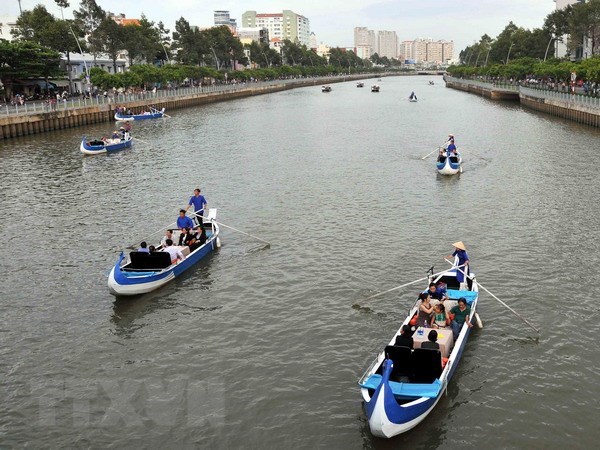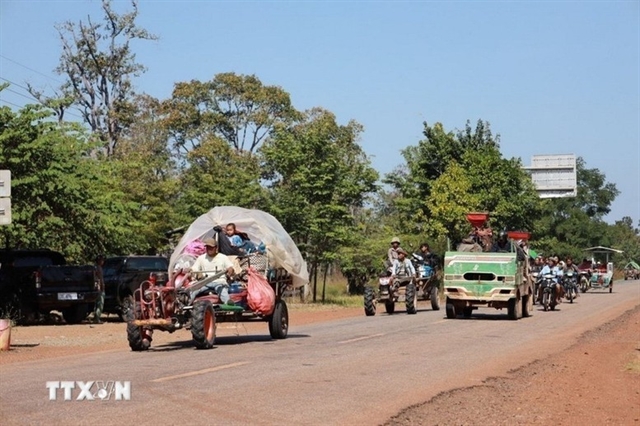 Society
Society

HCM City authorities have ordered the city Department of Natural Resources and Environment to work with agencies and district authorities to strictly monitor the discarding of litter and untreated sewage in canals in the city.

|
| The Nhiêu Lộc-Thị Nghè Canal was once seriously contaminated and considered a “dead canal” back in the 1950s, but was revitalised following a World Bank-funded clean-up project. VNA/VNS Photo Mạnh Linh |
HCM CITY — HCM City authorities have ordered the city Department of Natural Resources and Environment to work with agencies and district authorities to strictly monitor the discarding of litter and untreated sewage in canals in the city.
Under a programme to reduce environmental pollution in the 2016-20 period, HCM City aims to reduce surface water pollution by 90 per cent, according to the department.
In recent years, the city has dredged rivers and canals and has urged residents not to discharge waste into canals.
A recent water test at 21 locations throughout the Sài Gòn - Đồng Nai river system showed that all water samples met the standards set by the department. Sampled water at areas such as the Nhiêu Lộc – Thị Nghè canal also indicated improved quality.
However, canals and rivers that lie between various provinces and regions still show signs of heavy microbiological pollution, oxygen depletion and other problems.
In addition, waterways throughout the city are suffering from thousands of tonnes of waste and large amounts of untreated wastewater.
Though the city has heavily invested in canal protection every year, water quality is not expected to improve until public awareness of environmental protection improves, experts have said.
Manufacturers in the city have implemented environmental treatment solutions, but they are mostly small-scale and ineffective, according to the department.
New plans
The department said it would work with districts where rivers and canals are located to encourage citizens not to throw litter or sewage into the canals, especially the Nhiêu Lộc-Thị Nghè canal.
Factories and industrial parks that discharge over 1,000 cubic metres of wastewater a day must set up automatic measuring stations that directly link to the department, according to the city People’s Committee.
Companies should also be encouraged to use advanced equipment and technologies to minimise waste. The water quality monitoring network should be expanded and an environmental database established, it said.
Local authorities will be responsible for monitoring wastewater treatment in manufacturing facilities and requiring companies that do not have proper treatment solutions to invest in standard-quality systems.
To reduce the amount of toxins in the canal, the city will increase sewage pumping to at least 64,000 cubic metres per hour after heavy rains.
The flood-tide control sewers on the canal will also be monitored closely to regulate water levels in the rainy season and protect water quality.
The city plans to continue to strictly regulate all wastewater treatment systems in industrial parks, export processing zones, high-tech parks and industrial clusters.
It will also set up automatic wastewater measurement stations directly linked to the department.
HCM City targets collecting and treating all industrial and medical liquid wastes and 90 per cent of industrial fumes by the end of this year. It also plans to reduce surface water pollution by 90 per cent and air pollution by 70 per cent in comparison with 2011.
Cleaning up canals
The city has in recent years spent trillions of Vietnamese đồng to clean up its highly polluted canal network. Most canals are covered in rubbish and their water is often black and foul, making them look like sewers rather than canals.
According to the department, pollution levels in many canals is far above permitted levels.
The Nhiêu Lộc-Thị Nghè Canal, which runs through District 1, District 3, and Phú Nhuận, Bình Thạnh, and Tân Bình districts with more than 1.2 million residents living along it, was once seriously contaminated and considered a “dead canal” back in the 1950s.
The canal was revitalised following a World Bank-funded clean-up project, the first phase of which ended in 2012. — VNS




